Related Research Articles

Mario Bava was an Italian filmmaker who worked variously as a director, cinematographer, special effects artist and screenwriter, frequently referred to as the "Master of Italian Horror" and the "Master of the Macabre". His low-budget genre films, known for their distinctive visual flair and stylish technical ingenuity, feature recurring themes and imagery concerning the conflict between illusion and reality, as well as the destructive capacity of human nature. He was a pioneer of Italian genre cinema, and is regarded as one of the most influential auteurs of the horror film genre.
Sergio Martino is an Italian film director and producer, notable for his contributions to the giallo genre.
Ernesto Gastaldi is an Italian screenwriter. Film historian and critic Tim Lucas described Gastaldi as the first Italian screenwriter to specialize in horror and thriller films. Gastaldi worked within several popular genres including pepla, Western and spy films.

Umberto Lenzi was an Italian film director, screenwriter, and novelist.

Vampire in Venice, also known as Prince of the Night and Nosferatu In Venice is a 1988 Italian supernatural horror film directed by Augusto Caminito and an uncredited Klaus Kinski, and starring Kinski, Christopher Plummer, Donald Pleasence, and Barbara De Rossi. The story follows Professor Paris Catalano (Plummer), who travels to Venice following the trail of the last known appearance of Nosferatu (Kinski), who was seen at Carnival in 1786. Catalano learns through a séance that the vampire is seeking eternal death, and tries to put an end to its existence once and for all.
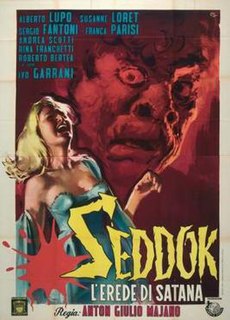
Atom Age Vampire is a 1960 Italian horror film directed by Anton Giulio Majano. Shot in black-and-white, the film was produced by Elio Ippolito Mellino and stars Alberto Lupo, Susanne Loret, and Sergio Fantoni.
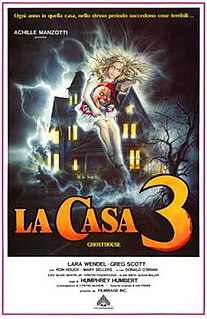
Ghosthouse is a 1988 Italian horror film written and directed by Umberto Lenzi. It co-starred Lara Wendel and Donald O'Brien. The plot focuses on a deserted house where the visions of a ghostly girl and her haunted doll wreak havoc on those who enter it.
Alberto De Martino was an Italian film director and screenwriter. Born in Rome, De Martino started as a child actor and later returned to the cinema where worked as a screenwriter, director and dubbing supervisor. De Martino's films as a director specialised in wellcrafted knock-offs of Hollywood hit films. These films were specifically created films in Western, horror and mythology genres which were developed for the international market. The Telegraph stated that his best known of these film was probably The Antichrist. The Antichrist capitalized on the box-office appeal of The Exorcist (1973) and in its first week in the United States earned a greater box office than Jaws.

Corrado Farina was an Italian film director, screenwriter, and novelist. He directed two feature films in the 1970s, many documentaries and commercials, and he published nine novels and an autobiography.
Piero Regnoli (1921–2001) was an Italian screenwriter and film director. Born in 1921, Regnoli worked in the film industry between 1953 and 1991 where he wrote over 110 screenplays and directed 11 films. Regnoli's work ranged from sword-and-sandal films, westerns, horror and sexy comedies. His final film where he was officially credited as a director was La principessa sul pisello in 1976. Regnoli did uncredited direction on the 1986 melodrama Giuro che ti amo starring Nino D'Angelo.

Dinner with a Vampire is a 1989 Italian television horror film directed by Lamberto Bava and written by Dardano Sacchetti. It was among four films made for the Italian television series Brivido Giallo.

L'iguana dalla lingua di fuoco is a 1971 giallo film. It is directed by Riccardo Freda, who was unhappy with the film and had his name replaced with the pseudonym "Willy Pareto".

The Playgirls and the Vampire is a 1960 Italian horror film directed and written by Piero Regnoli.

Naked Violence is a 1969 Italian crime film directed by Fernando Di Leo and based on the novel I ragazzi del massacro written by Giorgio Scerbanenco.
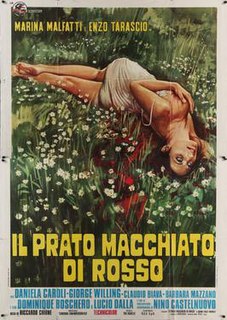
Il prato macchiato di rosso is a 1973 Italian film directed by Riccardo Ghione.
Berto Pisano was an Italian composer, conductor, arranger and jazz musician.

Amori pericolosi is a 1964 anthology film consisting of three segments directed by Alfredo Giannetti, Carlo Lizzani and Giulio Questi.
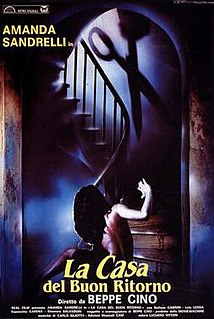
La Casa del Buon Ritorno is a 1986 Italian giallo written and directed by Beppe Cino.
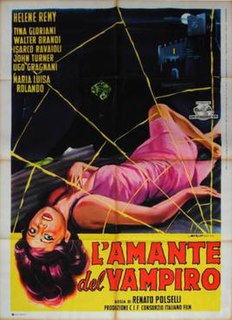
The Vampire and the Ballerina is a 1960 Italian horror film directed and co-written by Renato Polselli.

The Vampire of the Opera is a 1964 Italian horror film co-written and directed by Renato Polselli and starring Marco Mariani and Giuseppe Addobbati.
References
Sources
- Abruzzese, Alberto (August 24, 1986). "Ora vi racconto la mia sfida al cinema". L'Unità (in Italian).
- Curti, Roberto (2019). Italian Gothic Horror Films, 1980-1989. McFarland. ISBN 978-1476672434.
- Zanotto, Piero (September 9, 1986). "Dopo l'effimero viene L'Anemia". La Stampa (in Italian).